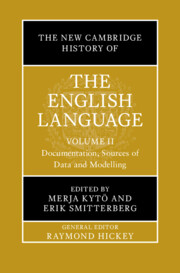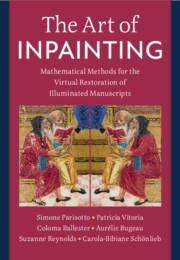Refine search
Actions for selected content:
130 results
Chapter 5 - Accounting to the Bishop
-
- Book:
- Local Priests in the Latin West, 900–1050
- Published online:
- 31 October 2025
- Print publication:
- 13 November 2025, pp 173-213
-
- Chapter
-
- You have access
- Open access
- HTML
- Export citation
The ‘alternative preface’ to Theophilos Korydalleus’ Logic: a minor episode of factional intrigue in the Patriarchal School of Constantinople in the seventeenth century
-
- Journal:
- Byzantine and Modern Greek Studies , First View
- Published online by Cambridge University Press:
- 03 November 2025, pp. 1-20
-
- Article
-
- You have access
- Open access
- HTML
- Export citation
5 - Internet Resources for the History of English
- from Part I - The Transmission of English
-
-
- Book:
- The New Cambridge History of the English Language
- Published online:
- 23 October 2025
- Print publication:
- 23 October 2025, pp 137-166
-
- Chapter
- Export citation

The New Cambridge History of the English Language
- Documentation, Sources of Data and Modelling
-
- Published online:
- 18 October 2025
- Print publication:
- 16 October 2025
5 - English Manuscript Traditions
- from Part I - The Textual Record
-
-
- Book:
- The New Cambridge History of the English Language
- Published online:
- 18 October 2025
- Print publication:
- 16 October 2025, pp 127-153
-
- Chapter
- Export citation
20 - The Language of Courtroom Documents
- from Part III - Genre and Medium in the Record
-
-
- Book:
- The New Cambridge History of the English Language
- Published online:
- 18 October 2025
- Print publication:
- 16 October 2025, pp 482-505
-
- Chapter
- Export citation
Bede’s Medical Books
-
- Journal:
- Early Medieval England and its Neighbours / Volume 51 / 2025
- Published online by Cambridge University Press:
- 07 October 2025, e13
-
- Article
-
- You have access
- Open access
- HTML
- Export citation
Chapter 7 - Travel Accounts in Manuscript and Print
- from Part I - Contexts
-
-
- Book:
- The Cambridge Guide to Global Medieval Travel Writing
- Published online:
- 03 October 2025
- Print publication:
- 02 October 2025, pp 127-149
-
- Chapter
- Export citation
A NOTE ON PLINY THE ELDER (HN 9.126)
-
- Journal:
- The Classical Quarterly , First View
- Published online by Cambridge University Press:
- 19 June 2025, pp. 1-3
-
- Article
- Export citation
Chapter 2 - Forming Responses
- from Part I - Responding to Exile
-
- Book:
- Medieval Responses to Ovid's Exile
- Published online:
- 27 May 2025
- Print publication:
- 12 June 2025, pp 49-89
-
- Chapter
- Export citation

The Art of Inpainting
- Mathematical Methods for the Virtual Restoration of Illuminated Manuscripts
-
- Published online:
- 22 May 2025
- Print publication:
- 22 May 2025
Appendix Manuscripts in Focus
-
- Book:
- The Art of Inpainting
- Published online:
- 22 May 2025
- Print publication:
- 22 May 2025, pp 178-182
-
- Chapter
- Export citation
5 - Methods Inspired from Cultural Heritage
-
- Book:
- The Art of Inpainting
- Published online:
- 22 May 2025
- Print publication:
- 22 May 2025, pp 162-174
-
- Chapter
- Export citation
Chapter 26 - Correspondence
- from Part III - Writings
-
-
- Book:
- Percy Shelley in Context
- Published online:
- 17 April 2025
- Print publication:
- 24 April 2025, pp 196-202
-
- Chapter
- Export citation
2 - Rome in 900
-
- Book:
- Rome in the Tenth Century
- Published online:
- 01 April 2025
- Print publication:
- 24 April 2025, pp 12-32
-
- Chapter
- Export citation
22 - Books, Libraries, and Texts
- from Part IV - Education, Culture, Arts
-
-
- Book:
- The Cambridge History of the Papacy
- Published online:
- 28 February 2025
- Print publication:
- 20 March 2025, pp 628-655
-
- Chapter
- Export citation
3 - Chronicles and the Court
- from Part I - Sources and Structures
-
-
- Book:
- The Cambridge Companion to Ottoman History
- Published online:
- 31 May 2025
- Print publication:
- 20 March 2025, pp 42-54
-
- Chapter
- Export citation
6 - Visual Sources for the Study of Ottoman History
- from Part I - Sources and Structures
-
-
- Book:
- The Cambridge Companion to Ottoman History
- Published online:
- 31 May 2025
- Print publication:
- 20 March 2025, pp 84-100
-
- Chapter
- Export citation
A PUZZLE IN THE MANUSCRIPT TRADITION OF POLYBIUS
-
- Journal:
- The Classical Quarterly , First View
- Published online by Cambridge University Press:
- 12 February 2025, p. 1
-
- Article
-
- You have access
- Open access
- HTML
- Export citation
5 - The Euchologion: Sources and Methods
- from Part III - Marriage Rites in Byzantine Liturgical Manuscripts
-
- Book:
- Marriage in Byzantium
- Published online:
- 01 May 2025
- Print publication:
- 23 January 2025, pp 183-210
-
- Chapter
- Export citation
